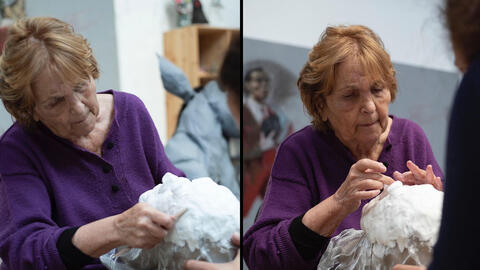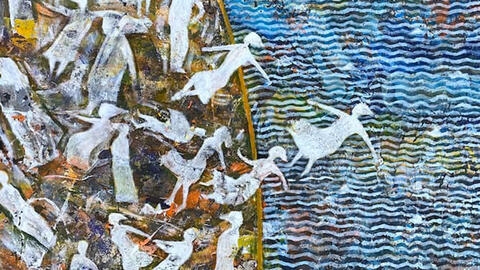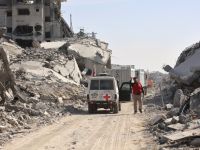Several artists are holding a collective exhibition at the Janine Rubeiz art gallery in Beirut.
The exhibition, which will go on until the end of June, includes works by seven artists with different artistic styles, namely Joseph Harb, Adlita Stephan, Alan Fasoyan, Ahmad Ghaddar, Elissa Raad, Christine Kattaneh and Maha Yammine.
Usually, group exhibitions, especially those held at the end of the artistic season, are presentations by emerging artists who are given a chance for the first time to showcase their artworks. At other times, such exhibitions are more like a wrap up of the artistic activity presented by the gallery during the past season. This is not the case of the current exhibition presented by the prestigious Janine Rubeiz gallery.
The artworks vary from video presentations, to paintings, sculptures and other art pieces. They depict the hellish atmosphere of human condition in a place called Lebanon.
The visitor will not find in this exhibition any warm colours, just extremely frosty hues. It is an infernal frost, which is primarily psychological.
In all countries wars happen and corruption occurs. Some countries are occupied and others are stifled by crises. In Lebanon, all of these happened but with a high degree of surrealism and absurdity, which art tries to capture.
The press release accompanying the exhibition comes full of fragmented ideas and ruptured expressions that echo the loud explosions, the sharpness of the blades.
The statement talks about “the barking of humanised dogs and pieces of bodies that are deprived of humanity”. It mentions chaos which “reigns supreme and overwhelms the ability to create art outside the logic of the absurd.”
Poetic description is often exaggerated, but not in this case. We do not know if the snapshot of modern Lebanon it suggests is enough to justify and explain what is displayed in the hall.
More than 30 years have passed since the end of the Lebanese war, at least officially. Then a few years passed during which the Lebanese felt that they were maybe faced with a new future and a new life, unaware that their numbed memory, along with the general amnesty that whitewashed the criminals, was to naively convince them of the end of the war before the demons woke up again. Demons multiplied over the next few years, becoming more fierce and sophisticated.
Then came the so-called Lebanese revolution, which sparked an uprising of awareness, which included all ages and social segments of society. After that, disasters and traumas of all kinds followed. Dreams were revived dozens of times before perishing on the altar of corruption and crime. Now they all became deep-rooted and resilient, requiring courage and perseverance to eradicate their manifestations. But until that happens, one can contemplate the works of art that throw erratic notions in the air like a delirium.
Among the artists participating in this exhibition, there is Joseph Harb, who presents a plastered sculpture of a human foot standing by itself and stripped of its natural walking ability.
Artist Christine Kattaneh presents an animation film and artistic print works in which she plays on the theme of the home.
Elsewhere in the gallery, artist Elissa Raad displays three oil paintings and 12 photographs. These are self-images that transform and change and remain foggy in meaning, more than in form and appearance, mirroring the nothingness of death in all its forms.
Ahmad Ghaddar presents a group of works titled “Inflation” and covering the deepening economic crisis whose numbers are extremely absurd and mercurial.
Adlita Stephan, presents highly poetic and eloquently arranged writings hanging on one of the gallery’s walls, entitled “He Knew” in reference to the political background of the explosion of the Port of Beirut in 2020 and the responsibility of a specific political figure who is emphatically supposed to have been aware of the presence of ammonium nitrate that blew up Beirut.
Alan Fasoyan displays kinetic sculptures and interactive artistic installations showcasing several dogs that refer to the massacre of stray dogs that recently occurred in Lebanon. It refers to all other massacres that took place and are still taking place every day in Lebanon.
Maha Yammine presents a video tape of five people playing cards, a game that the Lebanese have been playing for years. The game continues for hours on end, during which players are immersed in various conversations at the height of absurdity.
Time flows in the gallery. It flows before our eyes and appears to have a numbing even if infernal effect.
This article has been adapted from its original source.










